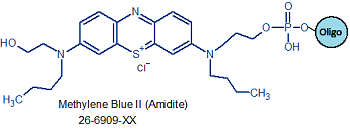
Modification : Methylene Blue II
Catalog Reference Number
Category
Modification Code
5 Prime
3 Prime
Internal
Molecular Weight (mw)
Extinction Coeficient (ec)
Technical Info (pdf)
Absorbance MAX
Emission MAX
Absorbance EC
26-6909
Redox Electrochemical
[MB-II]
Y
N
N
489.57
-
PS26-6909.pdf
668
-
-
| Catalog No | Scale | Price |
| 26-6909-05 | 50 nmol | $651.00 |
| 26-6909-02 | 200 nmol | $651.00 |
| 26-6909-01 | 1 umol | $767.00 |
| 26-6909-03 | 2 umol | $902.00 |
| 26-6909-06 | 5 umol | $3,451.50 |
| 26-6909-10 | 10 umol | $3,348.00 |
| 26-6909-15 | 15 umol | $4,455.00 |
| Discounts are available for Methylene Blue II! |
| Modification* Discount Price Structure |
|
1 site/order
|
List price
|
|
2 sites/order
|
10% discount
|
|
3 sites/order
|
20% discount
|
|
4 sites/order
|
30% discount
|
|
5-9 sites/order
|
50% discount
|
|
10+ sites/order
|
60% discount
|
|
*Exceptions apply
|
Some branching off the Methylene Blue II will occur when incorporated internally within an oligo, we recommend Methylene Blue II be placed at or near the 5' terminus of the oligo sequence.
Methylene blue II modification is an amidite that can be directly coupled by using automated chemistry. This requires the use of mild reagents for synthesis and there is an additional charge of $250 charge per order.
Methylene Blue (MB) NHS is a redox-active, heterocyclic aromatic dye that, when incorporated at the 5' or 3'-end of an oligonucleotide, enables the modified oligo's use as an electrochemical (EC) probe for nucleic acid analysis. Currently, there is considerable interest in using MB-modified oligonucleotides as aptamer probes for developing electrochemical DNA sensors for selective and sensitive detection of specific biochemical targets (DNA, RNA, proteins, etc.) in complex samples (for example, blood serum) (1,2). Such sensors are constructed by covalent attachment (typically through one or more thiol groups) of the MB-modified DNA probes to the surface of a gold electrode. The binding of target to probe leads to changes in the structural dynamics of the probe DNA that change the distance between the MB moiety and the gold surface. For "signal-on" sensors, the MB moiety moves close enough to the gold surface to cause electron transfer between the two, and generation of an electrochemical signal indicating presence of target in the sample (3). For "signal-off" sensors, the MB moiety moves away from the gold surface, halting electron transfer between the two, with the subsequent loss of an electrochemical signal indicating presence of target in the sample (4). Intensive work continues to move these systems beyond proof of principle and towards commercial availability.
Methylene blue is a pH indicator that changes color depending on the acidity or alkalinity of a solution. In acidic conditions (pH < 6), it appears blue, while in neutral to basic conditions (pH > 7), it can shift to a colorless or light blue form. This transition is due to changes in the molecular structure of methylene blue, which affects its light absorption properties.

References
1. Ricci, F., Lai, R.Y., Plaxco, K.W. Linear, redox modified DNA probes as electrochemical DNA sensors.
Chem. Comm. (2007),
36: 3768-3770.
2. Song, S., Wang, L., Li, J., Zhao, J., Fan, C. Aptamer-based biosensors.
Trends in Anal. Chem. (2008),
27: 108-117.
3. Ferapontova, E.E., Gothelf, K.V. Optimization of the Electrochemical RNA-Aptamer Based Biosensor for Theophylline by Using a Methylene Blue Redox Label.
Electroanalysis (2009),
21: 1261-1266.
4. Xiao, Y., Lubin, A.A., Heeger, A.J., Plaxco, K.W.. Label-free Electronic Detection of Thrombin in Blood Serum by Using an Aptamer-Based Sensor.
Angew. Chem. Int. Ed. Engl. (2005),
44: 5456-5459..
- Methylene Blue II
